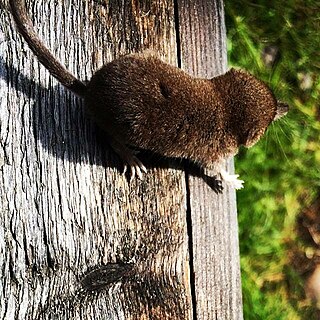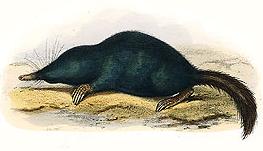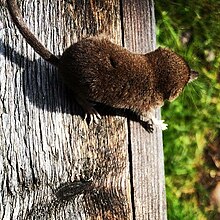
Shrews are small mole-like mammals classified in the order Eulipotyphla. True shrews are not to be confused with treeshrews, otter shrews, elephant shrews, West Indies shrews, or marsupial shrews, which belong to different families or orders.

The red-toothed shrews of the subfamily Soricinae are one of three living subfamilies of shrews, along with Crocidurinae and Myosoricinae. In addition, the family contains the extinct subfamilies Limnoecinae, Crocidosoricinae, Allosoricinae and Heterosoricinae. These species are typically found in North America, northern South America, Europe and northern Asia. The enamel of the tips of their teeth is reddish due to iron pigment. The iron deposits serve to harden the enamel and are concentrated in those parts of the teeth most subject to wear. Members of the genera Chimarrogale, Nectogale, Neomys (Nectogalini) and some members of Sorex (Soricini) are known as water shrews, due to having a semi-aquatic lifestyle.

The genus Sorex includes many of the common shrews of Eurasia and North America, and contains at least 142 known species and subspecies. Members of this genus, known as long-tailed shrews, are the only members of the tribe Soricini of the subfamily Soricinae. They have 32 teeth.

The barren ground shrew is a small shrew found in northern Canada west of Hudson Bay and in Alaska. At one time, this species was considered to be a subspecies of the similar cinereus shrew. It is similar in appearance and thought to be closely related to the Saint Lawrence Island shrew and Pribilof Island shrew.

The Gansu shrew is a red-toothed shrew found only in a small part of Gansu province and other adjacent areas of China. With its very limited range, it is sensitive to habitat loss and is listed as a "vulnerable species" in the Chinese Red List, while the IUCN lists it as being "data deficient"

Laxmann's shrew, or the masked shrew, is a species of shrew. Its range extends from northern Scandinavia and the Baltic to the Sea of Japan, including Hokkaidō, Sakhalin, and the Korean Peninsula. It favours mountain forests but is sometimes found in tundra and moorland, and also in lowland areas as well. It avoids cultivated land.

The Ryukyu shrew , also known as Orii's shrew, is a species of mammal in the family Soricidae. It is endemic to the Amami Islands of Japan. It is threatened by habitat loss.

The Iberian shrew or Lagranja shrew is a species of mammal in the family Soricidae. It is found in Portugal and Spain.

The ornate shrew is a species of mammal in the family Soricidae (shrews). It is endemic to western North America, ranging from Northern California in the United States to Baja California in Mexico. Eight subspecies are known, including the extinct tule shrew, known only from four specimens collected in 1905, and the Suisun ornate shrew, a species of conservation concern in California. Through skull morphology research and genetic testing on Ornate shrew populations, it has been shown that there are three main genetic subdivisions: The Southern, Central and Northern. These three genetic subdivisions of Ornate shrew arose from populations of Ornate shrews getting geographically isolated from other populations.
The Sado shrew is a subspecies of mammal in the family Soricidae. It is endemic to Japan, and more specifically, the Japanese island of Sado. Although it is sometimes referred to as its own species, more recent scholarship identifies it as a subspecies of the Shinto shrew. However, there are significant morphological differences between the species.

The Inyo shrew is a species of shrew found in the western United States. It is light gray and white in color, with a narrow skull and small body size, very similar in appearance to the related dwarf shrew, but paler and not as large. It can be found in many different habitats, from rocky, mountainous regions to wetlands and riparian areas. Not much is known about its behavioral and reproductive habits. While barely studied, their population is believed to be stable and not under any threat.

The Japanese shrew mole or himizu (ヒミズ) is a species of mammal in the family Talpidae. It is endemic to Japan and is found on Honshu, Shikoku, Kyushu, Awaji Island, Shodo Island, Oki Islands, Tsushima Island, Goto Islands, Mishima Island, and Awashima Island, but is absent from Hokkaido, which is north of Blakiston's Line. It is one of three Urotrichini and it is the only extant species in the genus Urotrichus. It is common between sea level and approximately 2,000 m. Sometimes this species is called the greater Japanese shrew mole and another species, True's shrew mole, is called the "lesser Japanese shrew mole".

The Japanese raccoon dog, is a species of canid endemic to Japan. It is one of two species in the genus Nyctereutes, alongside the common raccoon dog, of which it was traditionally thought to be a subspecies.

Hilgendorf's tube-nosed bat is a species of vesper bat in the family Vespertilionidae. In Japan they are called 'tengu komori', after the mythical creature called the Tengu. It was formerly thought to be a subspecies of Murina leucogaster, but is now known to be a distinct species.
The Japanese long-eared bat is a species of vesper bat endemic to Japan, where it is found in Hokkaido, Honshu and Shikoku. It has distinctive, long ears, hence its Japanese name, the 'rabbit bat'. Formerly included as a subspecies of the European bat Plecotus auritus, genetic studies now indicate Plecotus sacrimontis is a separate species.














